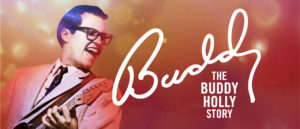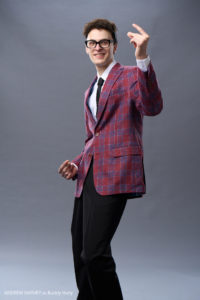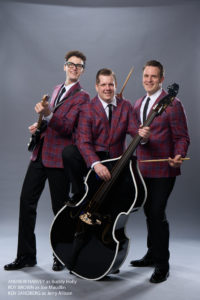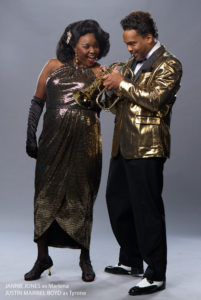IVINS — In the past three years alone, film has imagined the lives of Aretha Franklin, (Respect), Freddy Mercurcy (Bohemian Rhapsody), Elton John (Rocketman), and Elvis Presley (Elvis). Broadway has also caught the biopic fever with shows like Beautiful about Carole King and MJ about Michael Jackson. The magic of the biopic is that the music, which is built into the story, organically punctuates the show’s drama. The biopic is an excuse to indulge in the music of a beloved artist and humanize them in unexpected ways.

For me, Buddy Holly was an unlikely addition to the burgeoning genre—probably because I had never heard of him before. Although I had never caught wind of him, the Rock and Roll Hall of Fame, to which Buddy was inducted in 1986, certainly had. After seeing Buddy: The Buddy Holly Story directed by Keith Andrews and written by Alan Janes, I could see the merit of staging the life of the rock and roller, whose work pioneered a new genre of music. Buddy’s death in a plane crash at the age of 22 ended his career that was as prolific as it was short: he produced enough unreleased material that albums of his music came out for 10 years following his death.

So, I was not the target audience for the show. I had never heard a Buddy Holly song before, and the records that dotted the proscenium were more the stuff of vintage hipsters than artifacts from a happy past I grew up in. Still, the show’s nostalgia was irresistible, even if I could not hum along with the gentleman behind me.
The show opens as the rejected Buddy struggles to gain recognition for his unique sound. It is a classic underdog story that requires the audience love the main character, but the spastic physicality in Andrew Harvey’s performance as Buddy Holly made it difficult to connect with the character. For example, when Buddy launches into attack on a dismissive record producer with a flurry of arms, his bandmates pin him to the ground, where he flails in an uncoordinated tantrum. Eventually, I grew to love Buddy—his lanky body, excessive spunk, and more than anything his incredible voice—but his character took a minute to buy into.
Other elements of the show sat uncomfortably with me. When Buddy meets his future wife, Maria Elena, at her job, he begs her boss to let her off work, so he can get to know her. Without consulting Maria Elena about whether or not she would like to spend time with this practical stranger, her boss consents, saying, “She’s all yours.” In the 21st century, it is uncomfortable to watch a silent woman be passed off from one man’s custody to another’s. In another moment, Jayson Elliott as the Big Bopper slipped a questionable comment. According to the character, if the man in the audience said, “Oh baby, that’s what I like,” which was the catch-phrase of his song, more often to his wife, he would get a second honeymoon. It can be difficult to portray marginalized groups like women with dignity when the piece’s time period understood them as sexual objects managed by men. In moments like these, the line between the misogyny (and racism, too) of the time period and that of the production got blurry.

Thankfully, Maria Elena (played by Sophia Maria Guerrero) cleared things up a bit. Her outright resistance to discrimination as a woman and foreigner helped the show’s blind spots feel more palatable. Especially since Guerrero delivered her character’s indignance with a refreshing sense of realism and subtlety.
The objectionable moments were blips in a production that was musically dazzling. I was glad that the show was more concert than documentary of Buddy’s life because the cast’s musicianship, led by music director Angela C. Howell, was the most impressive part. As the Crickets played the peppy “Ollie Vee,” the show came together for me. Watching Harvey jam in a yellow plaid shirt and loose jeans, I could imagine the unseen world of the show—populated by shiny linoleum diners, poodle skirts, and Buddy’s music as the vibrant center of it all. I also loved the ending of “Words of Love” when the band sang a capella with the most beautifully balanced harmony.
The design elements of Buddy: The Buddy Holly Story were integral to the spectacle. A favorite moment from Julie Duro’s lighting design was the bright blue that enveloped the stage for the saccharine “Raining in My Heart.” Panels in the back of the set (designed by Bert Scott) set changed colors with the music, reinforcing the concert feel.
Roy Brown as Joe Maudlin played the bass in a variety of positions that were innovative and even acrobatic, though distracting at times from the other performances. At one point, he lay the bass on its side, laid himself on top of it, and kicked his feet in the air like it was the most carefree thing in the world. That over-the-top choice, similar to Harvey’s tantrum, summed up the exaggerated style that I initially resisted and then accepted as the show progressed.

Putting all the antics aside, the ending was the show’s dramatic crowning jewel. The last scene treats what was to be the final concert of Buddy’s life. In the middle of the performance—mid-song in fact—all the lights blacked out and the music halted as a narrator explained that following the show, Buddy and other performers would board the plane that would fail mid-flight. Haloed by a spotlight, Buddy stood motionless before me as something of a legend. Then, as quickly as the pause started, it ended, and the concert resumed full-force. Harvey, Elliott, and Estevan Hernandez as Ritchie Valens gave all their energy in “Johnny B. Goode.” Watching them travel in a line side to side doing the classic rock and roll kick, I felt all the thrill of a live performance, mingled with sadness about their impending doom. Moved to tears, I was reminded through the dramatic irony how abruptly life, like a song, can end. At this point, I didn’t just choose to accept Buddy; I loved him.
Overall, Buddy: The Buddy Holly Story is a beautiful tribute to a man whom I had the privilege of getting to know. Despite the murky politics and stylized acting, I enjoyed the show, and I am confident that Buddy Holly’s fans will love it even more. For the ending alone, I thought the production as a biopic was well-suited to the stage. The show, which reminds audience’s of their mortality, is also aware of its own “mortality” as an ephemeral art. If people convene at a theater to share a moment in time and space, Buddy reminds us that all existence is just as temporary and joy just as rare.
Other than the suddenness of tragedy, I learned not to take the show too seriously. It was designed to be entertainment and not a highbrow text for critical study. In my opinion, the best theatre combines both. If Buddy fit mostly into the former category, that still makes it a fun night out — even for a young whippersnapper.
[box]The Tuacahn production of Buddy: The Buddy Holly Story plays nightly (except Sundays) at 7:30 PM and Saturdays at 2 PM through August 13 at the indoor Hafen Theatre (1100 Tuacahn Drive, Ivins). Tickets are $24-66. For more information, visit tuacahn.org.[/box]

